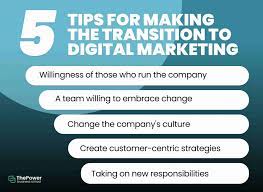Digital Marketing Transformation: Embracing the Power of the Digital Age
In today’s fast-paced and ever-evolving business landscape, digital marketing has become a crucial component of any successful marketing strategy. With the rapid advancements in technology and the increasing reliance on digital platforms, businesses must adapt and undergo a digital marketing transformation to stay relevant and competitive.
Digital marketing transformation refers to the process of integrating digital technologies into all aspects of marketing activities, from planning and execution to analysis and optimization. It involves leveraging various digital channels such as websites, social media, email, search engines, and mobile apps to reach and engage with target audiences effectively.
One of the key driving forces behind digital marketing transformation is the changing behavior of consumers. With more people spending a significant amount of time online, businesses need to meet them where they are – in the digital space. Traditional marketing methods alone are no longer sufficient to capture their attention or drive meaningful engagement.
By embracing digital marketing transformation, businesses can unlock several benefits that can propel their growth and success. Here are a few key advantages:
Enhanced Reach: Digital marketing allows businesses to reach a broader audience than ever before. With online platforms spanning across borders and time zones, geographical limitations are no longer barriers. This expanded reach opens up new opportunities for businesses to connect with potential customers globally.
Targeted Marketing: Digital channels provide powerful targeting capabilities that enable businesses to deliver personalized messages to specific segments of their audience. By understanding consumer preferences and behaviors through data analytics, businesses can create tailored campaigns that resonate with their target market, leading to higher conversion rates.
Cost-Effectiveness: Compared to traditional advertising methods like print or television ads, digital marketing offers cost-effective solutions for businesses of all sizes. With proper planning and execution, businesses can optimize their budget by targeting specific demographics or interests while tracking the effectiveness of each campaign in real-time.
Real-Time Data Analysis: One significant advantage of digital marketing is the ability to gather and analyze data in real-time. This wealth of information allows businesses to gain valuable insights into consumer behavior, campaign performance, and market trends. Armed with these insights, businesses can make data-driven decisions and refine their strategies for better results.
Improved Customer Engagement: Digital marketing opens up avenues for two-way communication between businesses and their customers. Social media platforms, for instance, provide an opportunity for businesses to engage directly with their audience, respond to inquiries or feedback promptly, and build meaningful relationships. This level of engagement fosters brand loyalty and customer advocacy.
To embark on a successful digital marketing transformation journey, businesses need to consider several key steps:
Set Clear Objectives: Define your goals and objectives for digital marketing transformation. Whether it’s increasing brand awareness, driving website traffic, generating leads, or boosting sales – having clear objectives will guide your strategy.
Build a Strong Online Presence: Establish a robust online presence through a well-designed website that is optimized for search engines and mobile devices. Leverage social media platforms to connect with your target audience and share valuable content that resonates with them.
Embrace Data Analytics: Invest in tools and technologies that allow you to collect and analyze data effectively. Monitor key metrics such as website traffic, conversion rates, click-through rates (CTR), and engagement levels to measure the success of your campaigns.
Stay Agile: The digital landscape is constantly evolving; therefore, it’s essential to stay agile and adapt quickly to emerging trends or changes in consumer behavior. Regularly review your strategies, test new approaches, and be open to experimentation.
Invest in Talent: Digital marketing transformation requires skilled professionals who are well-versed in the latest tools, techniques, and best practices. Invest in training or hiring individuals who can drive your digital marketing efforts forward.
Digital marketing transformation is not just a trend; it’s a necessity for businesses to thrive in the digital age. By embracing the power of digital technologies, businesses can expand their reach, engage with their target audience effectively, and drive growth. So, take the leap and embark on your digital marketing transformation journey today!
7 Essential Tips for Digital Marketing Transformation
- Identify and leverage emerging technologies
- Invest in customer experience
- Utilize data-driven insights
- Develop a comprehensive strategy
- Establish KPIs & track performance
- Optimize for mobile devices
- Integrate with other systems/platforms
Identify and leverage emerging technologies
In the ever-evolving digital marketing landscape, it’s important for businesses to stay ahead of the curve by identifying and leveraging emerging technologies. With the right strategy, businesses can capitalize on new technologies to create more efficient and effective marketing campaigns.
One way to identify emerging technologies is to keep an eye on industry trends. This could mean reading online publications or attending conferences and events that focus on digital marketing. It’s also important to stay in touch with industry professionals who may be able to provide insights into new technologies that could be beneficial for your business.
Once you have identified potential new technologies, it’s important to assess how they could be used in your marketing efforts. For example, if you are using a CRM system, you might consider leveraging artificial intelligence (AI) technology to help optimize customer segmentation or automate certain processes. Similarly, if you are looking for ways to increase user engagement on social media platforms, you might explore using augmented reality (AR) technology to create interactive experiences for your customers.
By taking the time to identify and leverage emerging technologies, businesses can gain a competitive edge in the digital marketing space. By staying ahead of trends and utilizing cutting-edge technology, businesses can ensure their campaigns remain effective and successful in the long run.
Invest in customer experience
Invest in Customer Experience: A Key Pillar of Digital Marketing Transformation
In the realm of digital marketing transformation, there is one crucial tip that businesses cannot afford to overlook: investing in customer experience. In today’s hyper-connected and highly competitive landscape, delivering exceptional customer experiences has become a fundamental aspect of any successful digital marketing strategy.
Customer experience encompasses every interaction a customer has with a brand, from the initial discovery phase to post-purchase support. It includes factors such as website usability, personalized communication, efficient customer service, and seamless transactions. By prioritizing and enhancing these touchpoints, businesses can foster strong relationships with their customers and differentiate themselves from competitors.
Why is investing in customer experience so vital for digital marketing transformation? Here are a few key reasons:
Increased Customer Loyalty: When customers have positive experiences with a brand, they are more likely to remain loyal and continue doing business with that company. By investing in customer experience, businesses can build trust and loyalty among their customer base, leading to repeat purchases and long-term relationships.
Positive Word-of-Mouth: Satisfied customers are more likely to share their positive experiences with others through word-of-mouth or online reviews. This organic advocacy can significantly impact a brand’s reputation and attract new customers. Investing in exceptional customer experiences creates opportunities for positive word-of-mouth marketing and helps generate valuable referrals.
Differentiation from Competitors: In today’s crowded digital marketplace, competition is fierce. Businesses need to find ways to stand out from the crowd. Investing in superior customer experiences sets a brand apart by creating memorable interactions that leave a lasting impression on customers. This differentiation can be a game-changer in attracting new customers and retaining existing ones.
Enhanced Brand Perception: The way customers perceive a brand plays a significant role in their decision-making process. Investing in customer experience shows that a business values its customers’ satisfaction and is committed to delivering value beyond just products or services. This commitment enhances the overall brand perception and can lead to increased customer trust and loyalty.
Improved Customer Retention and Lifetime Value: It is well-known that acquiring new customers can be more costly than retaining existing ones. By investing in customer experience, businesses can improve customer retention rates and increase customer lifetime value. Satisfied customers are more likely to make repeat purchases, spend more over time, and become brand advocates.
To invest in customer experience effectively, businesses should consider the following:
Understand Customer Needs: Take the time to understand your target audience’s preferences, pain points, and expectations. Use data analytics and customer feedback to gain insights into their behaviors and motivations.
Personalize Interactions: Leverage technology to deliver personalized experiences across various touchpoints. Tailor content, recommendations, and offers based on individual preferences to create a sense of personal connection with customers.
Streamline Processes: Identify areas where friction or inefficiencies exist in the customer journey and work towards streamlining those processes. Simplify website navigation, optimize checkout flows, and ensure prompt and effective customer support.
Continuously Improve: Regularly evaluate your customer experience efforts through feedback mechanisms such as surveys or social listening tools. Use this feedback to identify areas for improvement and implement necessary changes promptly.
Investing in customer experience is not just a one-time effort; it requires ongoing commitment and attention from businesses. By placing the customer at the center of digital marketing transformation initiatives, businesses can create meaningful connections that drive loyalty, advocacy, and ultimately business growth in today’s digital landscape.
Utilize data-driven insights
Utilize Data-Driven Insights: Unleashing the Power of Digital Marketing Transformation
In the era of digital marketing transformation, businesses have access to an abundance of data like never before. This data holds immense potential to drive strategic decision-making and fuel business growth. By utilizing data-driven insights, businesses can gain a competitive edge and maximize the effectiveness of their digital marketing efforts.
Data-driven insights refer to the process of collecting, analyzing, and interpreting data to gain valuable knowledge about consumer behavior, market trends, and campaign performance. These insights enable businesses to make informed decisions and optimize their strategies for better results.
One of the primary benefits of utilizing data-driven insights is the ability to understand your target audience better. By analyzing demographic information, online behavior patterns, and preferences, businesses can create highly targeted campaigns that resonate with their audience. This personalized approach increases engagement levels and enhances the overall customer experience.
Data-driven insights also help businesses identify trends and patterns in consumer behavior. By monitoring metrics such as website traffic, conversion rates, click-through rates (CTR), or social media engagement, businesses can identify what is working well and what needs improvement. This allows them to make data-backed adjustments in real-time, optimizing their marketing strategies for maximum impact.
Moreover, data-driven insights provide valuable feedback on campaign performance. Businesses can measure key performance indicators (KPIs) such as return on investment (ROI), cost per acquisition (CPA), or customer lifetime value (CLV). This information helps allocate resources effectively and identify areas where adjustments are needed for better outcomes.
To effectively utilize data-driven insights in your digital marketing transformation journey, consider these key steps:
- Data Collection: Implement tools or platforms that collect relevant data from various sources such as websites, social media platforms, email campaigns, or customer surveys. Ensure that you have a robust system in place to capture accurate and comprehensive data.
- Data Analysis: Utilize analytics tools or employ data analysts to interpret the collected data. Identify patterns, trends, or correlations that can provide valuable insights into consumer behavior and campaign performance.
- Actionable Insights: Translate the data analysis into actionable insights. Use these insights to inform your marketing strategies, content creation, targeting approaches, or campaign optimization techniques.
- Continuous Monitoring: Establish a system for ongoing data monitoring and analysis. Regularly review your KPIs to track progress and identify areas for improvement.
- Experimentation and Iteration: Embrace a culture of experimentation and iteration. Test different approaches based on data-driven insights and learn from the results. Continuously refine your strategies to stay ahead in the dynamic digital landscape.
In conclusion, utilizing data-driven insights is a crucial aspect of digital marketing transformation. By leveraging the power of data, businesses can gain a deep understanding of their audience, make informed decisions, optimize campaigns in real-time, and drive business growth. So, harness the potential of data-driven insights and unlock new levels of success in your digital marketing endeavors.
Develop a comprehensive strategy
Developing a Comprehensive Strategy: The Key to Successful Digital Marketing Transformation
In the rapidly evolving digital landscape, businesses must adapt and undergo a digital marketing transformation to stay competitive. One crucial tip for a successful transformation is to develop a comprehensive strategy that aligns with your business goals and target audience.
A comprehensive strategy serves as a roadmap that outlines the steps and tactics needed to achieve your digital marketing objectives. It encompasses various elements such as identifying target markets, defining key performance indicators (KPIs), selecting appropriate digital channels, and creating engaging content.
One of the first steps in developing a comprehensive strategy is understanding your target audience. Conduct thorough market research to identify their demographics, interests, behaviors, and pain points. This information will help tailor your messaging and choose the most effective digital channels to reach them.
Defining clear KPIs is another vital aspect of your strategy. These metrics will help you measure the success of your digital marketing efforts. Whether it’s increasing website traffic, improving conversion rates, or enhancing brand awareness, setting specific and measurable goals will guide your actions and allow you to track progress effectively.
Selecting the right digital channels is crucial for reaching your target audience efficiently. Consider platforms such as social media networks, search engines, email marketing, content marketing, or paid advertising. Each channel has its strengths and characteristics that can be leveraged based on your business objectives.
Creating engaging content is at the heart of any successful digital marketing strategy. Develop high-quality content that resonates with your target audience’s needs and interests. Whether it’s blog articles, videos, infographics, or social media posts – focus on delivering value and building meaningful connections with your audience.
Regularly analyze data and adjust your strategy accordingly. Monitor key metrics like website traffic, engagement rates, conversion rates, or ROI to evaluate the effectiveness of your campaigns. Use this data-driven insight to make informed decisions about optimizing future campaigns or reallocating resources.
It’s also important to stay updated with the latest digital marketing trends and best practices. The digital landscape is constantly evolving, and new opportunities arise regularly. Stay informed through industry publications, attend webinars or conferences, and engage with online communities to stay ahead of the curve.
Remember that digital marketing transformation is a journey that requires time, effort, and dedication. By developing a comprehensive strategy tailored to your business goals and target audience, you lay a solid foundation for success. So, invest in planning your digital marketing transformation today and embrace the power of the digital age!
Establish KPIs & track performance
Establish KPIs & Track Performance: The Key to Successful Digital Marketing Transformation
In the world of digital marketing, setting clear goals and tracking performance is crucial for success. As businesses undergo digital marketing transformation, it becomes even more important to establish Key Performance Indicators (KPIs) and closely monitor them to ensure that efforts are aligned with desired outcomes.
KPIs serve as measurable benchmarks that reflect the progress towards achieving specific objectives. They provide valuable insights into the effectiveness of digital marketing strategies and help businesses make informed decisions based on data-driven analysis.
When establishing KPIs for digital marketing transformation, it’s essential to consider the following factors:
- Align with Business Objectives: KPIs should be directly linked to broader business goals. Whether it’s increasing website traffic, improving conversion rates, or enhancing brand awareness, aligning KPIs with overarching objectives ensures that digital marketing efforts contribute directly to the growth and success of the business.
- Make Them Specific and Measurable: KPIs should be specific and easily quantifiable. For example, instead of aiming for “increased website traffic,” a specific KPI could be “increase organic website traffic by 20% within six months.” This allows for clearer tracking and evaluation of progress.
- Set Realistic Targets: While it’s important to set ambitious goals, it’s equally crucial to ensure that they are attainable. Setting unrealistic targets can lead to frustration and demotivation among the team. It’s better to set incremental goals that can be realistically achieved within a given timeframe.
- Choose Relevant Metrics: Select metrics that directly reflect progress towards the desired outcome. Depending on your objectives, relevant metrics could include website analytics (such as bounce rate or time spent on site), conversion rates, social media engagement (likes, comments), or email open rates.
- Regularly Monitor and Analyze Data: Tracking performance is an ongoing process. Regularly monitor the selected KPIs and analyze the data to gain insights into what’s working and what needs improvement. This allows for timely adjustments to strategies and tactics, ensuring that efforts are focused on activities that yield the best results.
- Use Data Visualization Tools: Utilize data visualization tools to present KPIs in a visually appealing and easily understandable format. These tools can help stakeholders grasp the performance at a glance, facilitating informed decision-making.
By establishing KPIs and diligently tracking performance, businesses can measure the impact of their digital marketing efforts accurately. This data-driven approach enables them to optimize strategies, identify areas for improvement, and allocate resources effectively.
Remember that digital marketing transformation is an ongoing journey. Regularly reviewing and adjusting KPIs based on changing business needs, market dynamics, and emerging trends is essential for continued success.
So, embrace the power of establishing KPIs and tracking performance as you embark on your digital marketing transformation. It will guide your efforts, provide valuable insights, and pave the way for achieving your business objectives in the dynamic digital landscape.
Optimize for mobile devices
Optimize for Mobile Devices: A Crucial Step in Digital Marketing Transformation
In the age of smartphones and tablets, optimizing your digital marketing efforts for mobile devices is no longer an option – it’s a necessity. With the majority of internet users accessing content through their mobile devices, businesses must prioritize mobile optimization as part of their digital marketing transformation strategy.
Mobile optimization refers to the process of creating websites, landing pages, emails, and other digital assets that are specifically designed to provide an optimal user experience on mobile devices. It involves ensuring that your content is easily accessible, visually appealing, and functional across various screen sizes and operating systems.
Why is optimizing for mobile devices so crucial in today’s digital landscape? Here are a few key reasons:
Mobile Usage is on the Rise: Mobile devices have become an integral part of our daily lives. People use their smartphones and tablets to browse the internet, shop online, access social media platforms, and interact with brands. By optimizing your digital assets for mobile devices, you tap into this growing audience and increase your chances of reaching potential customers.
Improved User Experience: A positive user experience is vital for engaging visitors and keeping them on your website or app. Mobile optimization ensures that your content loads quickly, navigation is intuitive, and text and images are easy to read and interact with on smaller screens. When users have a seamless experience on their mobile devices, they are more likely to stay engaged and convert into customers.
Search Engine Friendliness: Search engines like Google prioritize websites that are optimized for mobile devices in their search results. This means that if your website is not mobile-friendly, it may rank lower in search engine results pages (SERPs), resulting in reduced visibility and organic traffic. By optimizing for mobile devices, you improve your chances of ranking higher in search engine results and attracting more organic traffic.
Competitive Advantage: Mobile optimization is no longer just a nice-to-have feature – it’s a competitive advantage. Businesses that prioritize mobile optimization are more likely to stand out from their competitors and capture the attention of mobile-savvy consumers. By providing a seamless mobile experience, you build trust with your audience and increase the likelihood of them choosing your products or services over others.
When optimizing for mobile devices, consider the following best practices:
Responsive Web Design: Implement responsive web design, which automatically adjusts the layout and content of your website based on the user’s screen size. This ensures that your website looks great and functions properly on any device.
Mobile-Friendly Content: Optimize your content for mobile consumption. Use concise and scannable paragraphs, large fonts, and high-resolution images that load quickly on mobile devices.
Streamlined Navigation: Simplify your website’s navigation to make it easy for users to find what they’re looking for quickly. Use clear menus, dropdowns, and search functionality to enhance user experience.
Fast Loading Speed: Mobile users expect fast-loading websites. Optimize your website’s performance by compressing images, minifying code, and leveraging caching techniques to ensure speedy page load times.
By prioritizing mobile optimization as part of your digital marketing transformation strategy, you can reach a wider audience, provide an exceptional user experience, improve search engine visibility, and gain a competitive edge in today’s mobile-centric world. So don’t overlook this crucial step – optimize for mobile devices and unlock the full potential of your digital marketing efforts!
Integrate with other systems/platforms
Integrating with Other Systems/Platforms: A Key Tip for Digital Marketing Transformation
In the rapidly evolving digital landscape, businesses must adapt and embrace digital marketing transformation to stay competitive. One essential tip for a successful transformation is to integrate your digital marketing efforts with other systems and platforms.
Integrating with other systems and platforms allows businesses to streamline their operations, improve efficiency, and enhance the overall customer experience. Here’s why integration is crucial in the context of digital marketing transformation:
Seamless Data Flow: Integrating your digital marketing systems with other platforms, such as customer relationship management (CRM) software or e-commerce platforms, ensures a seamless flow of data between different systems. This enables you to have a unified view of your customers’ interactions across various touchpoints.
Personalized Customer Experiences: By integrating your digital marketing platforms with CRM systems, you can access valuable customer data that helps in creating personalized experiences. This integration enables you to deliver targeted messages based on customers’ preferences, purchase history, or browsing behavior.
Efficient Campaign Management: Integration allows for efficient campaign management by automating workflows and reducing manual efforts. For example, integrating your email marketing platform with your CRM system can help automate lead nurturing campaigns based on specific triggers or actions taken by customers.
Enhanced Analytics and Reporting: Integrating different systems consolidates data from multiple sources into one central location. This enables comprehensive analytics and reporting, providing deeper insights into campaign performance, customer behavior, and return on investment (ROI).
Improved Marketing Attribution: Integration between various systems facilitates accurate attribution modeling. By tracking customer interactions across channels and attributing conversions correctly, businesses can gain a better understanding of which marketing efforts are driving results.
To make the most out of integration during your digital marketing transformation journey, consider these best practices:
Identify Key Integration Points: Determine which systems and platforms are crucial for your digital marketing efforts. This could include CRM systems, e-commerce platforms, content management systems (CMS), marketing automation tools, or social media platforms.
Choose the Right Integration Tools: Explore integration tools and solutions that align with your business requirements. Look for options that offer seamless data synchronization, ease of use, scalability, and compatibility with your existing systems.
Collaborate with IT and Marketing Teams: Effective integration requires collaboration between IT and marketing teams. Encourage open communication and collaboration to ensure smooth implementation and ongoing support.
Regularly Monitor and Optimize: Continuously monitor the performance of your integrations to identify any issues or areas for improvement. Regularly optimize your integration processes to ensure data accuracy, reliability, and security.
Integrating your digital marketing systems with other platforms is a vital step in achieving a successful digital marketing transformation. By doing so, you can unlock the full potential of your data, streamline operations, deliver personalized experiences, and drive better results. Embrace integration as a key strategy in your digital marketing transformation journey today!





Outstanding story there. What happened after?
Take care!
Thank you for your comment! In the realm of digital marketing transformation, businesses strive to enhance customer experiences, optimize strategies, and leverage emerging technologies to stay ahead in the digital age. Your interest in the topic is appreciated. Take care!